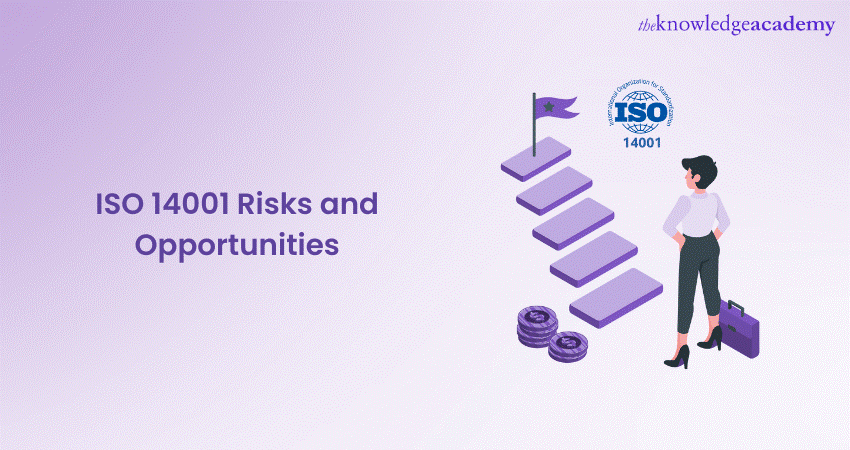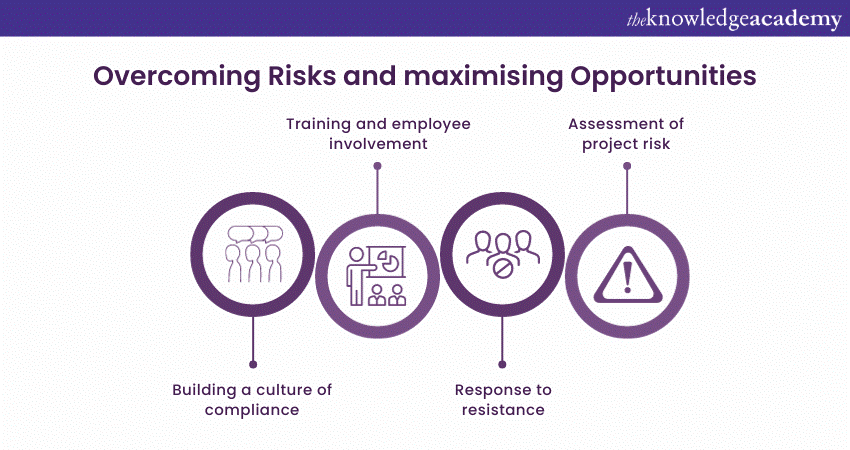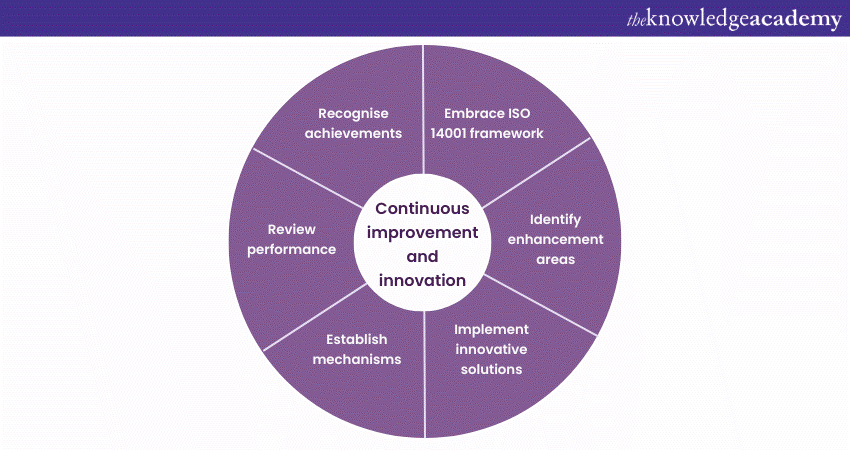We may not have the course you’re looking for. If you enquire or give us a call on 01344203999 and speak to our training experts, we may still be able to help with your training requirements.
Training Outcomes Within Your Budget!
We ensure quality, budget-alignment, and timely delivery by our expert instructors.

Are you willing to implement ISO 14001? Or are you already on your journey to achieve environmental excellence? Whichever the situation, it is crucial to consider ISO 14001 Risks and Opportunities.
Implementing ISO 14001 can bring numerous benefits, but it also comes with its own set of Risks and challenges. Understanding these Risks and Opportunities is crucial for organisations to improve their environmental performance, enhance their corporate image, and gain a competitive edge.
But how to achieve this balance? How can one identify Opportunities and eliminate Risks? Read this blog to take a deeper dive into the ISO 14001 Risks and Opportunities. Also, address the key challenges and opportunities associated with this standard.
Table of Contents
1) Understanding ISO 14001
2) ISO 14001 Risks and Opportunities
3) Risks associated with ISO 14001
4) Opportunities offered by ISO 14001
5) Overcoming Risks and maximising Opportunities
Understanding ISO 14001
ISO 14001, an internationally recognised standard, provides organisations including the ISO 14001 Context of the organisation with a framework for effective Environmental Management. It sets the criteria for an Environmental Management System (EMS), which helps organisations identify and control their Environmental Aspects and Impacts through the use of an Environmental Aspect and Impacts Register. Enhancing systematic compliance and continual improvement through ISO 14001 Document Control
This standard emphasises the need for continual improvement and encourages organisations to adopt a proactive approach towards environmental sustainability. Further, it provides a structured framework for organisations to minimise their environmental footprint, conserve resources, and enhance their overall environmental performance.
Therefore, by implementing ISO 14001, organisations can systematically establish processes and procedures to environmental responsibilities throughout the ISO 14001 Life Cycle. Additionally, they can also ensure compliance with applicable legal and regulatory requirements utilising ISO 14001 Software to enhance efficiency and effectiveness in environmental management.
ISO 14001 Risks and Opportunities
ISO 14001 is an international standard that specifies the requirements for an Environmental Management System (EMS) that aims to protect the environment and prevent excessive pollution. The standard was revised in 2015 to introduce the concept of Risks and Opportunities, which replaced the previous preventive action process. Explore the changes in ISO 14001 version 2004 vs 2015 for more insights
Risks and Opportunities are the potential representation of positive or negative impacts on the achievement of the EMS objectives due to internal or external factors and influences. The standard requires organisations to identify and assess the Risks and Opportunities related to their Environmental Aspects, compliance obligations, and context and to plan actions to address them. The purpose of this process is to ensure that the EMS can meet its intended outcomes, prevent or reduce undesired effects, and achieve continual improvement.
The Risk-focused method in ISO 14001 makes the previous demands about precautionary actions more specific. However, the core, prevention, and avoidance, remains the same. Management can effectively manage Risks and Opportunities by integrating Environmental Management into business processes and their strategic direction and decision-making.
ISO 14001 is a voluntary standard that can benefit organisations of different types and sizes by providing them with a framework for improving their environmental performance, enhancing their reputation, reducing costs, and increasing customer satisfaction. The standard is compatible with other Management System standards, such as ISO 9001 (Quality Management) and ISO 45001 (Occupational Health and Safety), and can be easily implemented and audited.
ISO 14001 is a valuable tool for organisations that want to demonstrate their commitment to environmental sustainability and social responsibility. By adopting the standard, organisations can also contribute to global efforts to combat climate change and protect biodiversity.
Risks associated with ISO 14001
While ISO 14001 offers numerous benefits, organisations must also be aware of the Risks arising during its implementation. By understanding these risks, organisations can take proactive measures to mitigate them effectively. The following are some of the common Risks associated with the ISO 14001 Standard:
Regulatory non-compliance
One of the significant Risks organisations faces is the failure to comply with Environmental Regulations. Non-compliance can result in fines, legal penalties and reputational damage. Therefore, it is crucial for organisations to stay updated with evolving regulations and ensure their EMS addresses all relevant compliance requirements.
Inadequate resource allocation
Inadequate resource allocation can undermine the effectiveness of the Environmental Management System (EMS). It can also lead to gaps in compliance, hinder improvement initiatives, and hinder the organisation’s ability to achieve its environmental objectives. Therefore, organisations must allocate the necessary resources to support the successful implementation and maintenance of ISO 14001.
Lack of management commitment
When top-level management does not demonstrate a genuine commitment to Environmental Management, it can create a lack of direction and hinder the engagement of employees. Management commitment is essential to drive change, allocate resources, and foster a culture of environmental responsibility throughout the organisation.
Insufficient employee engagement
Lack of employee engagement can result in resistance to change, inadequate implementation of environmental practices, and missed opportunities for improvement. Therefore, organisations should implement effective document control measures under ISO 14001, including training and engagement initiatives to ensure employees understand their roles and actively contribute to the success of ISO 14001.
Ineffective communication and documentation
Inadequate communication of environmental policies, objectives, and procedures can lead to misunderstandings, inconsistent practices, and non-compliance. Similarly, insufficient documentation of processes and records can hinder the organisation's ability to monitor, measure, and improve its environmental performance. Thus, organisations must establish robust communication channels and maintain accurate documentation to support ISO 14001 implementation.
Take the first step towards sustainability by joining in our ISO 14001 Training today.
Opportunities offered by ISO 14001
Organisations that achieve ISO 14001 Compliance not only fulfill their environmental responsibilities, but also unlock a spectrum of growth and improvement opportunities. Embracing ISO 14001 enables organisations to tap into the following prospects:
Improved environmental performance
ISO 14001 provides a structured framework for organisations to assess and improve their Environmental performance. By implementing the standard’s requirements, organisations can identify and manage their Environmental Aspects and impacts more effectively. As a result, they cannot only benefit the planet but can also lead to cost savings, operational efficiency, and enhanced reputation.
Enhanced corporate image
The 14001 Certification serves as credible proof of an organisation’s environmental responsibility. Therefore, it enhances its corporate image, positioning it as a socially responsible entity that cares about the environment and its stakeholders.
Access to new markets and business opportunities
Many clients, both in the public and private sectors, prioritise working with environmentally responsible organisations. ISO 14001 Certification can serve as a differentiating factor when competing for contracts or attracting investors. By expanding their market reach, organisations can grow their business and tap into new revenue streams.
Cost reduction and efficiency
By optimising resource use, organisations can achieve cost savings and improve operational efficiency. For example, energy-saving initiatives, recycling programs, and improved waste management can reduce utility bills, lower material costs, and streamline processes.
Competitive advantage
ISO 14001 Certification can enable organisations to meet customer expectations, comply with tender requirements, and access new markets. It can be a differentiating factor when competing for contracts or attracting investors. By positioning themselves as environmentally responsible, organisations can stand out from their competitors and obtain a competitive advantage.
Enhance your auditing skills and contribute to a greener future with our ISO 14001 Internal Auditor course.
Overcoming Risks and maximising Opportunities
Implementing ISO 14001 brings forth various Risks and Opportunities for organisations. To ensure successful implementation and reap maximum benefits, addressing these Risks effectively while capitalising on the Opportunities presented is crucial. So, let’s explore key strategies to overcome Risks and maximise Opportunities:

Building a culture of compliance
Risk: Non-compliance with Environmental Regulations and Standards can result in legal consequences, reputational damage, and financial penalties.
Solution:
a) Foster a culture of compliance by promoting environmental responsibility at all levels of the organisation
b) Communicate the importance of adhering to environmental regulations
c) Encourage employees to embrace their role in compliance
d) Develop and implement robust processes and systems to examine and ensure compliance with applicable laws and standards
e) Review and update procedures to stay current with evolving regulations
Training and employee involvement
Risk: Lack of awareness and understanding of ISO 14001 requirements among employees can hinder successful implementation.
Solution:
a) Offer comprehensive training programs to educate employees about ISO 14001, its objectives, and their roles and responsibilities in the implementation process
b) Emphasise the significance of their contribution to Environmental Management
c) Encourage their active participation and involvement in identifying improvement opportunities and implementing sustainable practices
d) Regularly communicate updates and successes to keep employees engaged and motivated
Continuous improvement and innovation
Opportunity: ISO 14001 provides a framework for continuous improvement and drives innovation in Environmental Management.
Solution:

a) Embrace ISO 14001 as a catalyst for continuous improvement
b) Encourage employees to identify areas for enhancement
c) Implement innovative solutions that reduce Environmental Impacts and enhance efficiency
d) Establish mechanisms to collect and analyse data on key environmental performance indicators
e) Regularly review performance against objectives and targets, seeking opportunities for further improvement
f) Recognise and celebrate achievements to reinforce the culture of continuous improvement
Stakeholder engagement
Opportunity: Engaging stakeholders can unlock valuable opportunities for collaboration, knowledge sharing, and enhanced Environmental Performance.
Solution:
a) Identify key stakeholders such as suppliers, customers, local communities, and regulatory bodies
b) Foster open lines of communication and collaboration to understand their concerns and expectations
c) Involve stakeholders in decision-making processes related to Environmental Management
d) Seek their input and consider their perspectives when developing strategies and initiatives
f) Collaborate on joint projects, partnerships, and knowledge-sharing initiatives to leverage collective expertise and maximise Environmental Impact
Conclusion
Understanding ISO 14001 Risks and Opportunities is a significant step towards effective Environmental Management for organisations. By addressing these risks and capitalising on opportunities, organisations can create a culture of environmental responsibility, compliance, and continuous improvement.
Join our ISO 14001 Foundation course and be part of the global movement towards a greener future.
Frequently Asked Questions
Upcoming ISO & Compliance Resources Batches & Dates
Date
 ISO 14001 Foundation Certification
ISO 14001 Foundation Certification
Mon 17th Jun 2024
Mon 21st Oct 2024







 Top Rated Course
Top Rated Course



 If you wish to make any changes to your course, please
If you wish to make any changes to your course, please


